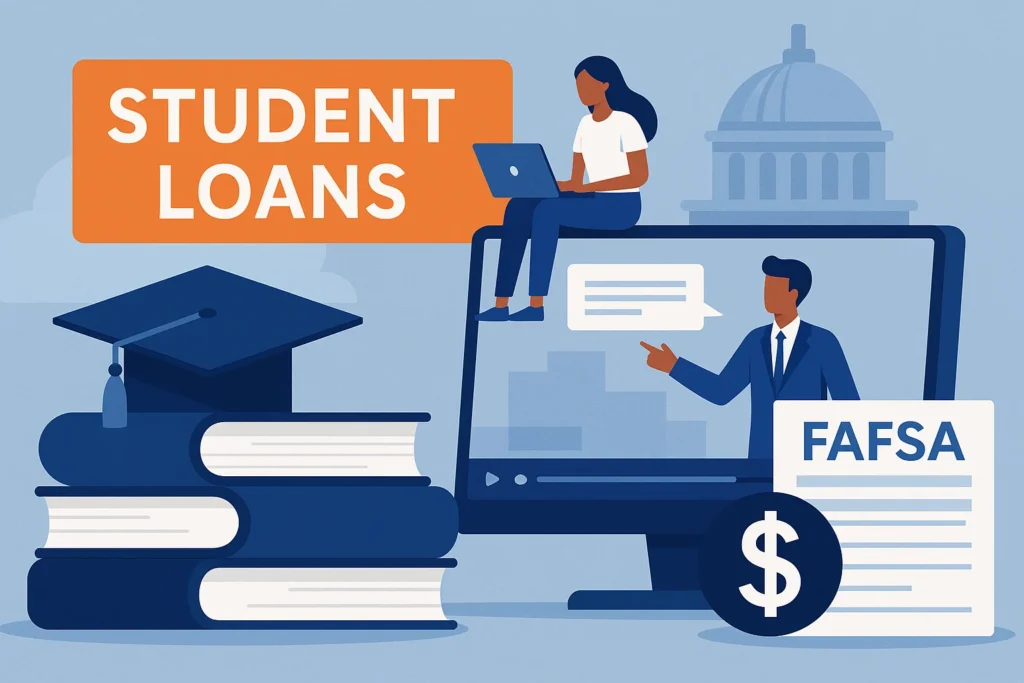Introduction: The Ever-Changing Classroom
Imagine going to school, not just in a building, but through a screen, connecting with teachers and classmates from miles away. Or picture a future where the mountain of college debt that weighs on so many seems a little smaller, or even disappears for some. Education in America is constantly evolving, driven by new technologies, big ideas about fairness, and the ongoing challenge of making learning accessible to everyone.
It’s a story of transformation, from how we pay for college to how we learn and who gets to learn. For students today, and for those dreaming of higher education, understanding these shifts is like having a map for an exciting, but sometimes bumpy, journey. Let’s explore some of the major changes shaping education in the U.S. right now.
The Weight of College Dreams: Student Loans and the Quest for Forgiveness
For many Americans, college is a doorway to a brighter future. But for just as many, that doorway comes with a hefty price tag: student loans. The idea is simple – borrow money to pay for your education, then pay it back once you start working. However, over time, the cost of college has risen much faster than wages, leading to a huge amount of student debt across the country – over $1.7 trillion owed by approximately 44 million Americans!
This has led to a big conversation: how can we make this burden lighter? This is where efforts around student loan forgiveness come into play.
Recent Changes in Loan Forgiveness
The government has been trying out different ways to help borrowers. One major effort involves income-driven repayment (IDR) plans. These plans adjust your monthly payments based on how much you earn, aiming to make them more affordable. For example, the “Saving on a Valuable Education” (SAVE) plan, introduced by the current administration, was designed to lower monthly payments even further for many, sometimes as low as $0, and offered forgiveness of remaining balances after 20 or 25 years of payments. This approach aimed to provide ongoing relief, rather than waiting for a single, large cancellation at the very end.
However, the world of student loan policies is always moving, and there have been discussions and proposals from different political groups to modify these approaches. Some ideas suggest simplifying the landscape by consolidating current repayment plans, potentially leading to different forgiveness timelines or payment structures, and emphasizing a shift from existing programs like SAVE. It’s important to remember that these policies are complex and can face legal challenges, meaning students and borrowers need to stay informed about how different plans might affect their financial future.
Public Service Loan Forgiveness (PSLF): A Special Path
Beyond these broader plans, there’s a unique program called Public Service Loan Forgiveness (PSLF). This program is specifically designed for people who dedicate their careers to public service, working full-time for a government agency or a qualifying non-profit organization. If they make 120 (which is 10 years’ worth) qualifying monthly payments, their remaining federal student loan balance can be forgiven, completely tax-free. This initiative aims to encourage individuals to pursue important public service roles, such as teaching in underserved communities, nursing, or working for charitable organizations, without being held back by student debt. The government continues to refine this program, sometimes offering temporary waivers to help more people qualify for past payments.
Making Sense of Aid: FAFSA Reform
Getting help to pay for college often starts with a form called the Free Application for Federal Student Aid, or FAFSA. For years, this form was well-known (or infamous!) for being long, complicated, and confusing. It felt like solving a puzzle just to figure out what financial help you might be eligible for.
A New, Simpler FAFSA
Recognizing this challenge, Congress passed the FAFSA Simplification Act in 2020, leading to a major overhaul. Starting with the 2024-2025 school year, the FAFSA has undergone significant changes to make it more user-friendly:
- Shorter and Streamlined: The number of questions has been significantly reduced, from over 100 to about 46. For many students, the online version is designed to be dynamic, meaning they’ll only see questions relevant to their specific situation, making the process quicker and less daunting.
- Direct Data Exchange: Now, applicants are generally required to use the IRS Direct Data Exchange. This means your tax information is automatically pulled directly from the IRS into your FAFSA, saving you from digging through old tax returns and reducing potential errors. It’s crucial that all “contributors” (like parents or spouses who need to provide information) consent to this data transfer.
- New Terminology: The old “Expected Family Contribution” (EFC), which often confused families into thinking it was the exact amount they’d have to pay, has been replaced with the “Student Aid Index” (SAI). The SAI can even be a negative number, better reflecting students with the greatest financial need.
- Expanded Pell Grant Eligibility: These changes are expected to make more students from low-income backgrounds eligible for the maximum Pell Grant, which is a type of federal grant that doesn’t need to be repaid. This means more money directly in students’ pockets without adding to their debt.
- More School Choices: Students can now send their FAFSA information to up to 20 colleges online, up from the previous limit of 10, giving them more flexibility in their college search.
While the new FAFSA is designed to be much easier, its initial rollout has faced some technical glitches and delays, causing frustration for students and colleges alike. Despite these hurdles, the ultimate goal is to unlock financial aid for more students and simplify the path to higher education.
Learning Beyond the Classroom: Digital Learning Trends
Remember how we started by imagining learning through a screen? The pandemic dramatically accelerated the adoption of online learning, transforming it from a niche option to a mainstream approach for millions of students. But digital learning is much more than just video calls; it’s a rapidly evolving field filled with innovation.
The Rise of Flexibility and Personalization
- Hybrid Learning: One of the biggest trends post-pandemic is the rise of hybrid learning, which blends online and in-person instruction. This offers students more flexibility, allowing them to access lectures online at their own pace while still having opportunities for face-to-face interaction and hands-on learning in a traditional classroom setting.
- Interactive Content: Gone are the days of just reading static text on a screen. Modern digital learning uses engaging multimedia, such as video lectures, interactive simulations, and virtual labs, to make learning more dynamic and effective. Imagine dissecting a virtual frog or conducting chemistry experiments safely on your computer!
- Personalized Learning with AI: Artificial intelligence (AI) is rapidly changing online education. AI-powered tools can adapt learning content to an individual student’s needs and pace, offering personalized recommendations, intelligent tutoring systems, and even automated feedback on assignments. Imagine an AI tutor that knows exactly where you’re struggling and provides extra practice just for you, whenever you need it!
- Mobile Learning: With smartphones almost universally available, learning on the go is easier than ever. “M-learning” allows students to access educational content through apps and responsive websites from anywhere, anytime, making education fit seamlessly into busy lives, whether on a bus or during a quick break.
- Gamification and Social Learning: To keep students engaged, many platforms are incorporating “gamification” – adding game-like elements such as points, badges, and leaderboards to make learning feel more like a fun challenge. Online learning also increasingly includes social components like live discussion forums, collaborative document editing, and group projects, fostering connection and teamwork even when students are physically apart.
While digital learning offers incredible flexibility and new possibilities, it also brings challenges, such as ensuring everyone has reliable internet access and the necessary devices, and making sure students stay motivated when learning independently outside a traditional classroom structure.
Opening Doors: Education Accessibility for All
A truly fair education system means everyone, regardless of their background, location, or circumstances, should have the chance to learn and succeed. But in the U.S., achieving full education accessibility faces several hurdles that need to be addressed.
Major Challenges
- Economic Disparities: One of the biggest barriers is simply money. Families from low-income communities often struggle to afford not just college tuition, but also basic school supplies, transportation, and even the “hidden” costs of public K-12 education. This financial strain can lead to missed opportunities and a widening gap in learning outcomes between students from different economic backgrounds.
- Geographical Challenges: In rural or remote areas, access to good schools and a wide range of educational resources can be limited. Long commutes or a lack of public transportation can make it difficult for students to attend regularly or participate in extracurricular activities.
- Teacher Shortages and Quality: Many schools, especially in disadvantaged areas, struggle to recruit and retain highly qualified teachers. This can lead to larger class sizes, less individualized attention for students, and a lower overall quality of instruction.
- Digital Divide: While online learning offers incredible flexibility, it also highlights the “digital divide.” Not all students have reliable high-speed internet access or the necessary digital devices at home, creating a significant barrier to participating in modern digital learning environments.
- Discrimination and Social Exclusion: Students from marginalized groups, including ethnic minorities, recent immigrants, refugees, and individuals with disabilities, can unfortunately face discrimination or social exclusion within educational settings, impacting their access to and experience within education.
- Mental Health: The increasing prevalence of mental health challenges among students across all age groups also affects their ability to engage in learning. Schools are increasingly recognizing the need to provide adequate support services.
Initiatives for a More Accessible Education
Fortunately, many efforts are underway to break down these barriers:
- Equitable Funding: There’s a push to reform how schools are funded, especially at the K-12 level, to ensure that schools in low-income areas receive enough resources to provide a quality education. This also includes advocating for more state and federal funding, and expanding scholarships and grants to ease financial burdens for college students.
- Improved Infrastructure: Investing in better school buildings, safer transportation options, and critical digital infrastructure (like expanding broadband internet access in underserved areas) is crucial for leveling the playing field.
- Strengthening Teacher Training and Support: Programs are focusing on recruiting and retaining high-quality teachers, especially in high-need areas, and providing ongoing professional development to equip educators with the best strategies.
- Inclusive Education Practices: Schools are adopting “universal design for learning” principles. This means that learning materials and environments are designed from the start to be accessible to students with diverse needs, rather than just adding accommodations later. This includes providing assistive technologies like text-to-speech tools or alternative formats for learning.
- Community Partnerships: Schools are increasingly working closely with families and local community organizations to create a supportive network around students, addressing needs both inside and outside the classroom.
- Technology for Access: Technology is being leveraged to improve access, not just through flexible online learning platforms, but also through adaptive software and hardware that can specifically assist students with disabilities or those with different learning styles.
These initiatives are all part of a larger goal: to ensure that every child, regardless of their background or where they live, has the opportunity to receive a quality education and reach their full potential.
College Affordability: Beyond Loans and Forgiveness
While student loans and related policies are a big part of the discussion, the core issue of college affordability itself needs to be addressed. How can we make the initial price tag of higher education less daunting in the first place, reducing the need for massive borrowing?
Strategies to Lower the Cost of College
- Community Colleges: Starting at a community college can significantly reduce the cost of the first two years of a bachelor’s degree. Tuition is often much lower, and students can then transfer their credits to a four-year university, saving tens of thousands of dollars.
- State Schools vs. Private: Public state universities are generally more affordable than private colleges, especially for in-state residents. While private schools might offer more financial aid, their initial “sticker price” is often substantially higher.
- Scholarships and Grants: These are “free money” that doesn’t need to be repaid. Students can actively apply for thousands of scholarships based on academics, specific interests, ethnic background, community service, or intended fields of study. Diligently filling out the FAFSA early also helps maximize eligibility for federal grants like the Pell Grant.
- Work-Study Programs: Federal work-study allows students to earn money through part-time jobs while attending college. These jobs are often related to their field of study or provide valuable campus experience, helping to offset costs without taking on more loans.
- AP Credits and Dual Enrollment: High school students can earn college credits through Advanced Placement (AP) exams or dual enrollment programs, where they take actual college courses while still in high school. This can significantly reduce the number of courses needed once they are officially in college, saving both time and tuition money.
- Living Off-Campus: While living on campus offers convenience and a unique experience, choosing to live off-campus, especially with roommates, can often be a more affordable housing option, particularly in larger university towns.
- Transparent Pricing: The government provides tools like the College Scorecard and the College Affordability and Transparency Center. These resources help students and families compare college costs, average student loan debt for graduates, and track tuition price increases across various institutions. This transparency helps families make more informed financial decisions about where to invest in higher education.
The ultimate goal isn’t just to make college cheaper, but to ensure that the investment in higher education truly pays off for students, leading to good job opportunities, personal growth, and a strong financial future, rather than a lifetime burdened by unmanageable debt. This involves encouraging colleges to be accountable for student outcomes and costs.
Conclusion: Investing in Tomorrow’s Minds
The journey of education in America is a dynamic one, constantly adapting to new challenges and opportunities. From rethinking how we manage student debt through evolving forgiveness policies and a simplified FAFSA, to embracing the power of digital learning and innovative teaching methods, and striving to make education truly accessible for every student – these are all pieces of a larger, ongoing puzzle.
The discussions around student loans, FAFSA reform, online learning, and college affordability aren’t just about policies and technology; they’re about people. They’re about ensuring that young Americans have the tools, the knowledge, and the support to achieve their dreams and contribute meaningfully to a stronger society. It’s a continuous effort, but one that’s vital for the future of individuals and the nation as a whole.



